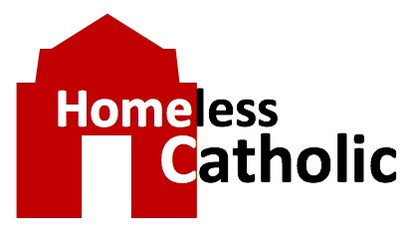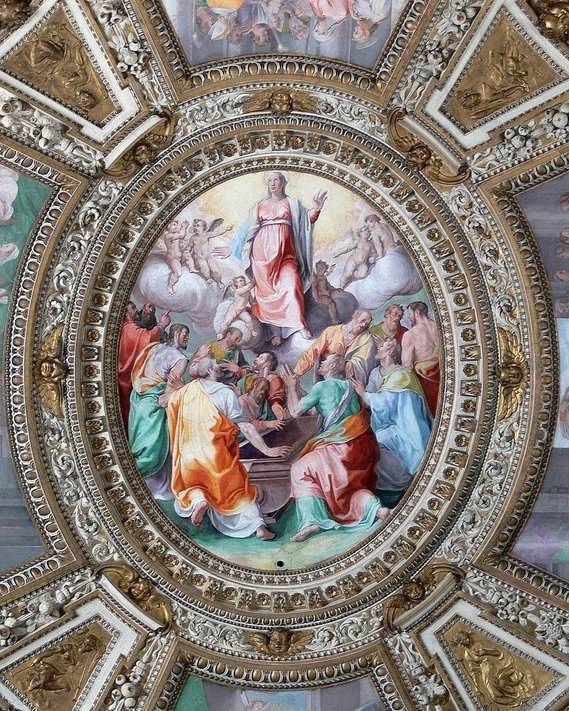The Assumption and Going Back to School
I sometimes find myself learning quite a bit more than I was expecting when I research the supporting details for the daily reading I’m reflecting on. For me, preparing a reflection is a several part process. I read the readings for the day, think about my first impressions, look for connections or similarities between the readings, and decide if there is a “main point” that I can use for a reflection presentation.
Can I relate the readings to some events in my life or current events? Often, I find that going back to verses before the daily readings gives a more complete context to the story and use that information to enlighten my Wednesday men’s group audience (and possibly the subscribers of The Homeless Catholic).
Today was different.
Image by Jacques Savoye
What a Difference a Date Makes
By Steve Leininger
http://www.usccb.org/bible/readings/081520-day.cfm
Revelation 11:19; 12:1-6, 10
1 Corinthians 15:20-27
Luke 1:39-56
I sometimes find myself learning quite a bit more than I was expecting when I research the supporting details for the daily reading I’m reflecting on. For me, preparing a reflection is a several part process. I read the readings for the day, think about my first impressions, look for connections or similarities between the readings, and decide if there is a “main point” that I can use for a reflection presentation.
Can I relate the readings to some events in my life or current events? Often, I find that going back to verses before the daily readings gives a more complete context to the story and use that information to enlighten my Wednesday men’s group audience (and possibly the subscribers of The Homeless Catholic).
Today was different.
We do our weekly reflections based on a given day of the week and we are currently doing Saturday (not the Saturday message you would hear at the Saturday evening mass, which “counts” for Sunday, but the Saturday during the day Mass, as it might be referred to. Next Saturday is August 15. In the Roman Catholic Calendar, that is a very special date. I could have read the title for the day, but I didn’t. It would normally have said “Saturday of the Nineteenth Week in Ordinary Time.” My first hint that something was different was that I had a choice of two readings: one for the Vigil, the other for Solemnity of the Assumption of the Blessed Virgin Mary.
I read both, looking for the one that would be the most relevant or thought-provoking or some other edge that would make for a good reflection. To me, it was notable that there were three readings in each set, one more than the usual “non-Sunday” readings.
I felt that the Assumption message was more interesting that the Vigil and proceeded to dig deeper. The gospel reading was the story of Mary and her visit to her cousin Elizabeth. You know, “the infant (the future John the Baptist) leapt in her (Elizabeth’s) womb” and Elizabeth proclaiming, “Most blessed are you among women, and blessed is the fruit of your womb.” It’s a very familiar story, I could show a map of Mary’s journey of around 100 miles and speculate on how long this trip might have taken.
I had a nagging feeling that I was missing more important details. Why were there 3 Bible readings instead of 2? I’ll admit that as a “Catholic by choice,” I am lacking a complete Catholic education on certain things that others seem to know. So, I’m going to take you on my journey to understanding a little bit more about Catholic history. Maybe you will learn something as well.
Holy Days of Obligation
One of the first things I found out was that for Catholics, there are currently six “holy days of obligation”:
- One Solemnity of Mary, Mother of God (Jan 1)
- Ascension of the Lord (40 days after Easter)
- Assumption of the Virgin Mary (Aug 15)
- All Saint's Day (Nov 1)
- Immaculate Conception of the Virgin Mary (Dec 8)
- Solemnity of the Nativity of the Lord (Christmas) (Dec 25)
On these days, a special set of readings is used to support the special day. Of those 6 holy days of obligation, Mary is the primary focus in 3. One could argue that she was “best supporting actress” for the Nativity, too. August 15, the focus of my investigation, is always a holy day of obligation, which means you’d better be in church!
Which readings on what date?
The readings for each day of the year are specified in The Lectionary for Mass, a primary resource for what to read when. I knew that part. I also knew that the Sunday readings were on a 3-year cycle, Cycles A, B, and C. But something I learned was that for the weekday readings, there is a Year I and Year II, a 2-year cycle. The new "Liturgical Year" always begins on the First Sunday of Advent, between November 27 and December 3. We are currently in Sunday Cycle A and Weekday Year II.
If Saturday in the middle of August was any day but the 15th, the heading for the readings would have been the much more mundane sounding Saturday of the Nineteenth Week in Ordinary Time. The gospel reading for either year is Matthew 19:13-15:
Children were brought to Jesus that he might lay his hands on them and pray. The disciples rebuked them, but Jesus said, "Let the children come to me, and do not prevent them; for the Kingdom of heaven belongs to such as these." After he placed his hands on them, he went away.
A nice short gospel, one with lots of possibilities. But not the date I was dealt.
Dogma
I re-read the heading for today’s readings -- Solemnity of the Assumption of the Blessed Virgin Mary. The gospel was certainly focused on Mary, the mother of Jesus, but didn’t go into any details on the Assumption. That seems odd! Time to dig deeper.
The reason there are no Bible readings on the Assumption of Mary is, well, there are no Bible readings on the Assumption of Mary. What’s that all about? The definition of the Assumption can be found in the glossary of the Catechism of The Catholic Church:
Assumption - The dogma which recognizes the Blessed Virgin Mary's singular participation in her Son's Resurrection by which she was taken up body and soul into heavenly glory when the course of her earthly life was finished.
There’s a hint there . . . dogma. Again from the glossary of the Catechism of the Catholic Church we find dogma defined as a solemn declaration by an ecumenical council or by the Pope that a doctrine is revealed by God and must be believed by the universal Church; such definitions are called infallible, and must be adhered to with the obedience of faith.
Note that there is not a requirement for scriptural or historical facts for such a solemn declaration, though there is generally a history of belief and tradition that leads to dogmatic declarations. If the Pope or ecumenical council declare something as dogma, it must be believed by the universal Church (that’s you and me) and the declaration is infallible (you can’t question it). That’s why dogma is only used in the rarest of declarations from the church hierarchy.
The dogma of Mary
Mary was the subject of four of the church’s dogmatic definitions:
- Mother of God
- Perpetual virginity
- Immaculate Conception
- Assumption
Let’s look at each one.
Mother of God
As early as the 3rd century, Mary had been referred as Theotokos, a Greek word that means “Mother of God” or “God-Bearer.” The status of Mary as Theotokos was a topic of theological dispute in the 4th and 5th centuries, until the Council of Ephesus in AD 431 decreed that Mary is the Theotokos because her son Jesus is both God and man: one divine person with two natures (divine and human) intimately and hypostatically united.
Perpetual virginity
The perpetual virginity of Mary is the doctrine that Mary, the mother of Jesus Christ, was a virgin before, during and after the birth of Christ. Mary's pre-birth virginity is attested in the New Testament, but there is no biblical basis for her perpetual virginity. At the end of the 2nd century some believed that sex and marriage were symptoms of original sin. In the 4th century controversies centered on the question of whether scripture did or did not indicate that Mary had other children. In 390 Mary's perpetual virginity was established as the only orthodox view and the Council of Ephesus in 431 established a fully general consensus on the doctrine of Mary’s perpetual virginity.
Immaculate Conception
The Immaculate Conception is a dogma of the Roman Catholic Church which states that the Virgin Mary was free of original sin from the moment of her conception. It proved highly controversial in the Middle Ages, gained acceptance in the 19th century and was adopted by the church as dogma when Pope Pius IX elevated it from doctrine to dogma in 1854. Immaculate Conception is one of the 6 holy days of obligation.
Assumption
In 1950 Pope Pius XII invoked papal infallibility to define the dogma of the Assumption of the Blessed Virgin, which says “We proclaim and define it to be a dogma revealed by God that the immaculate Mother of God, Mary ever virgin, when the course of her earthly life was finished, was taken up body and soul into the glory of heaven.”
What did I learn?
Rather than prepare a normal reflection, centered on the day’s gospel, I took myself to school on the workings of our Catholic faith. The day of my reflection fell on August 15, which is the Assumption of the Virgin Mary, a holy day of obligation. I learned that there are currently 6 such days in the church year. I learned that the Sundays are on a 3-year rotation and weekdays (non-Sundays, actually) are on a 2-year rotation for the readings. I learned about church’s dogmatic declarations and the 4 dogmas that are directly related to Mary, the mother of Jesus and cousin to Elizabeth, and that 2 of these dogmas were relatively ancient and 2 were in the last couple centuries.
Thank you for joining me on my journey!

